While repairing problems yourself is tempting if you’re a DIY fan or wish to save up on repair costs, it’s not always the best option. What could seem like child’s play to repair can reveal instead a complicated step-by-step process that takes too long to get to the source of the issue and ultimately costs you time and even more money.
No need to worry, we’ve got you covered. Here’s some common problems you’ll encounter on your e-bike as well as some advice that might help in choosing between (temporarily) fixing on your own and bringing it to a repair boutique.
Flat Tires
You may be an expert in replacing your regular bike’s tire, but if you want to do that for your e-bike, you’re in for a bit more of a complicated process on your hands.
An e-bike's tires are linked to its pedal assist system and the bike’s battery, so in most cases you’ll have to safely undo those connections, replace the tire, then redo all of it. If these are done incorrectly, your e-bike's pedal assist function might not even work at all, requiring more effort to pedal than previously, and if there’s serious damage the entire system might need to be replaced.
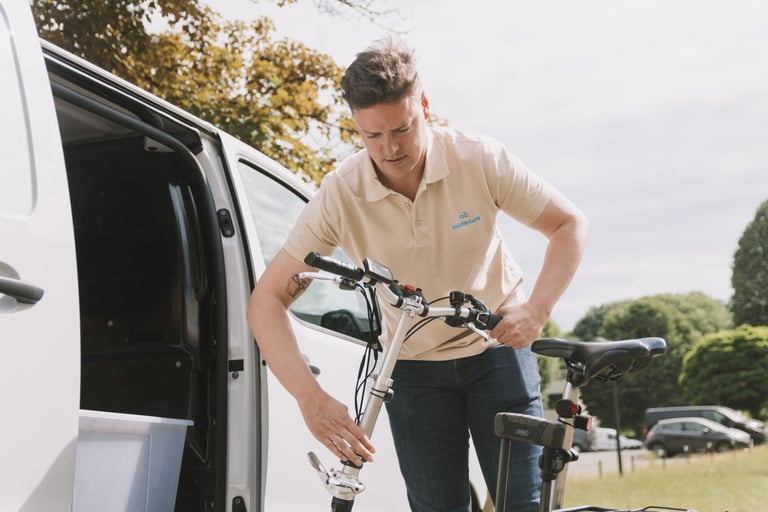
Always make sure if you’re replacing the tires yourself, to try as much as possible to find accurate and trustworthy guides on how to do so for your specific e-bike model. If the nitty-gritty work and know-how needed are not speaking to you, it’s largely safer and faster to bring it to the professionals.
Speed Issues

Are you feeling like you’re not getting as much speed as you used to? That more effort is required to reach the speed you used to get?
Buckle up, because there could be several reasons why that’s the case:
Your tuning settings, or the mode itself may have changed, from sport to eco for example. If everything is how you normally set it, check if it’s simply a mechanical problem.
There could be dirt stuck between the chains, or they might be too little or much too tight. Cleaning and adjusting the chains to have the right tension for you could do the trick.
If neither of these are affected, it could be a side effect of certain pieces or wires connecting them being damaged. Certain sensors that send information to the pedal assist system could also not be functioning properly, resulting in the wheels not being “connected” to the electronic aspects of the e-bike.
Unfortunately, if the minor adjustments do not solve the issue, we highly recommend you bring your e-bike to a trusted repair centre for deeper diagnostics, since the most important part of the repair process is understanding exactly what is causing the issue.
Brake Issues
Brake issues are relatively straightforward for DIY repairs. The most common piece that needs to be replaced are the brake pads, which naturally get worn and torn over time depending on how often you break, and the speed at which you break.
Replacing them is often as simple as loosening the piece that holds them, putting them in the new one then retightening it. If you feel it’s soon time to replace them, it might be more efficient to get those replaced if your e-bike is already under repair.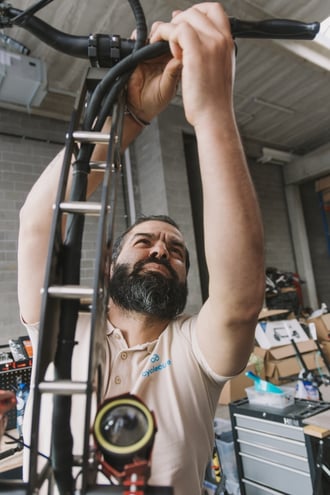
Another common issue is the brake lever becoming too tight over time. Simply loosen the part the brake cable passes through, adjust the cable so that it’s just the right level of tightness – not too much or too little, then test them out. If braking is still not satisfactory, you might need to check your callipers, but be very careful since damaging those will affect the brake cables dramatically. As with all issues, if in doubt, call your professionals.
Battery Issues
Battery Issues come wide and varied, and are the most dangerous problems to solve yourself. For these, we highly recommend relying on professionals to do the entire diagnostics and repairing process themselves. If you are noticing problems, make sure to note everything from “the battery performance feels like it dropped” to “the battery no longer charges or dies randomly in the middle of a ride” so that the mechanics can know better where to start from during the check-up process. As such, I will be detailing the most common battery issues to look out for.
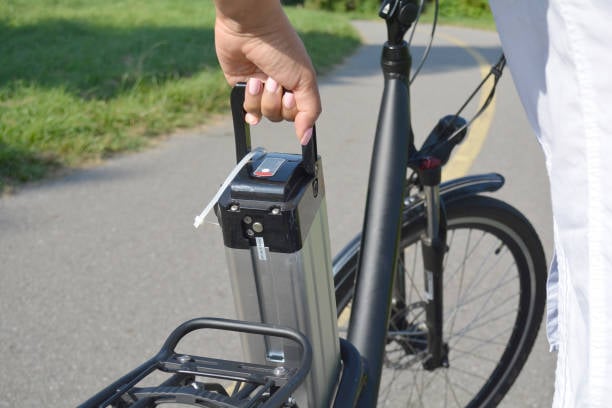
Shorter Battery Life and Range
Shorter battery life is quite normal and usually is a result of natural degradation of the battery after several charging cycles. The reason for this is that different types of batteries are built for a different amount of “charge cycles” , the process of the battery going from 0% charge to 100%. Lithium batteries are the most common ones, but its charge cycle capacity ranges between 300 and 500 for a Lithium Polymer battery and 700 for Lithium-Ion batteries, where with the distance travelled it degrades more and more over time. Since this is the case, once you start noting a lower battery capacity and rideable travel distance ask yourself how long you have been using your e-bike for, and if it is only a couple of months, get it checked with professionals to see if the battery is still in good condition.
It is also important to note that each battery has a different amount of supported charge cycles depending on the quality of how and with what it was made. If you’re looking to buy a new e-bike, make sure to ask for the full details on its battery life.
Charging Issues
Charging issues could stem from a damaged charging port, a broken charger, to problems with the battery itself. If you feel that your e-bike’s battery is not charging as fast as it used to, that the battery feels unnaturally hot, or it is simply not charging at all, contact the shop you bought it at if your e-bike is still under warranty. If it isn’t, it’s better to bring it to a professional repair shop to check what the issue is, since it not charging could point to a battery management system issue (BMS) or overheating, a more dangerous sign that could be indicative of a swelling battery.
Battery Management System (BMS) Issues
The BMS can be the reason for many battery related issues for e-bikes, since it regulates how the battery is charged and discharged while also transferring the power to the motor. Additionally, it is in charge of regulating the temperature of the battery so that it does not overheat nor damage its quality. Do not worry, if a BMS is damaged or dead, it will stop your battery from getting charged to ensure no damage happens.
If your e-bike is facing discharging issues, such as battery capacity being largely reduced, it draining too fast, or emptying without using your e-bike, the BMS could be failing rather than dead.
Replacing the BMS is a tricky process. It can be repaired or replaced, but because it is closely linked to the battery itself, while costly, it is often preferable to simply replace the battery to save on time, and prevent further complications by opening up the battery.
Swelling Battery
This is the most serious of e-bike battery issues, most common in Lithium-ion batteries and Lithium Polymer batteries, but not as much for all types.
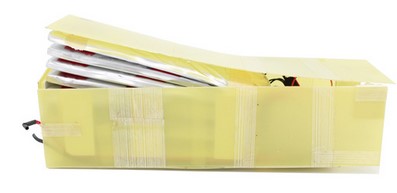
For Lithium-ion batteries, if the battery pack itself is composed of flat pack cells, it will be more prone to swelling if they suffer physical or electrical damage, natural degradation or water damage as opposed 18650 Lithium-ion cells which are more reliable due to its build being much more resistant to swelling.
To know if your e-bike’s battery pack is swelling, check for bulges that stick out on your battery. Depending on how it was designed, full battery may be visible from the outside, whereas for others you might need to remove it from the frame to check. If the battery pack is indeed swelling, take it out, absolutely do not charge your e-bike with a swelling battery to prevent it from catching fire or exploding. Bring your e-bike to a trusted e-bike repair professional, and check for further maintenance issues to see if the problem came to be from electrical issues causing damage, or any other reason. Unfortunately, it is too dangerous to attempt to repair this type of battery issue and would result in you needing to buy a new one, but the unusable battery can be given to a dedicated recycling centre within your city.
Pedal Assist Issues
As mentioned previously, Pedal-Assist system (or PAS) is the feature that aids you when pedalling on your e-bike, making it require less effort to reach faster speeds and easier to climb hills or ride against wind.
.jpg?width=5184&height=3456&name=42T-Chainring%20(1).jpg)
This works through built-in sensors that detect your pedalling motion and speed, information that is then communicated to the motor so that the e-bike can provide you with optimal assistance. The degree of assistance can be adjusted on the dashboard, or through the e-bike’s app for certain models. Now that this has been reiterated, what are the possible issues you may come across with your PAS?
Sensor Issues
If your pedal assist is not working, working inconsistently, or engaging with a delay it could be due to the sensor malfunctioning. Reasons for that could simply be due to the magnets that the sensor is dependent on being dislocated or misaligned. This can be seen physically and depending on the degree of the displacement can be fixed and adjusted on the spot once you’ve come to a full stop. If you prefer not to tinker with it yourself, your e-bike professionals should be able to easily fix it, or find deeper rooted problems that would have otherwise been missed.
Lack of Power Assistance
This is usually electronic in nature. If you’re pedalling and feel that there is zero to no pedal assistance, it could be due to your battery not having enough charge left, faulty wiring, or electronic issues that cause the sensor to malfunction. Visually it is hard to notice, but with proper diagnostics from professionals any and all problems would be found.
What does repairing your e-bike yourself boil down to?
Confidence, experience, and a mixture of safety vs cost saving. These are fundamentally the most important things needed if you want to DIY repair.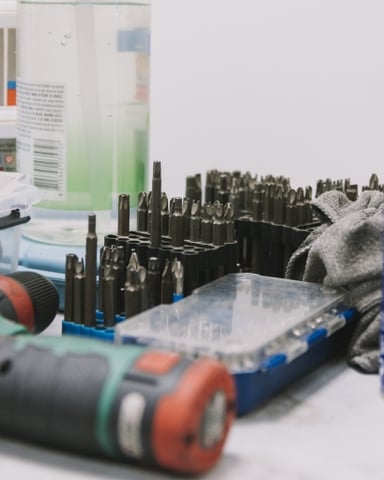
You need to have confidence in yourself, the knowledge of the problem and your ability to cleanly repair or replace pieces and to truly understand the benefits of doing it yourself, or having it done by a professional.
For problems with easy solutions such as tuning breaks or checking you’re on the right speed mode, there is little to worry about as long as you check how the changes impact your riding right after. Always make sure to at least find a video of a similar problem being repaired for the exact model you have.
However, for electronics and mechanical pieces that are behind several layers of mechanisms, you can’t be overconfident. You need to truly know the issue, what and how it will be repaired, and be extremely careful that no further damage comes out of the repair.
While making mistakes can provide valuable learning experiences, they are expensive mistakes, much less secure and less tested than bringing them to professionals. You may not pay for the labor costs with DIY, but you’ll never have to reorder the right pieces, or worry about safety with professionals.
Looking for the right professionals to repair your ride? Book a repair with us at:

August 28, 2023
